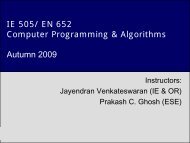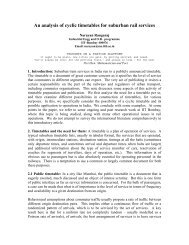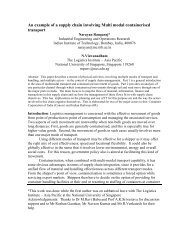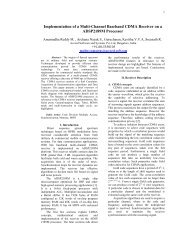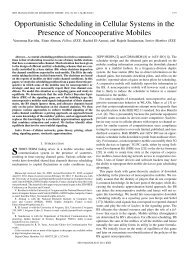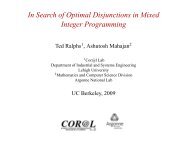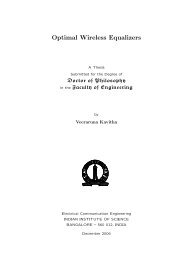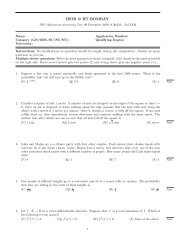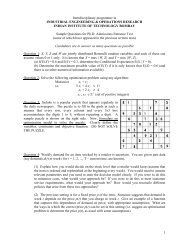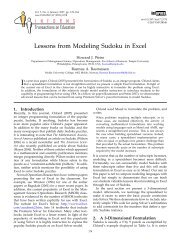A Monte Carlo Approach to Currency Risk Minimization - IEOR @IIT ...
A Monte Carlo Approach to Currency Risk Minimization - IEOR @IIT ...
A Monte Carlo Approach to Currency Risk Minimization - IEOR @IIT ...
You also want an ePaper? Increase the reach of your titles
YUMPU automatically turns print PDFs into web optimized ePapers that Google loves.
CVaR 0.95 (ψ T ) E(ψ T |ψ T < 0) P(ψ T |ψ T < 0)Unhedged 0.7245 0.3545 0.5179Static Heuristic 0.3534 0.1732 0.5253Dynamic Heuristic 0.3975 0.1790 0.6091Static Hedging 0.0104 0.0099 0.4892Dynamic Hedging 0.0104 0.0096 0.2770Table 1: Comparison of Optimal Static and Dynamic Hedging Strategies with HeuristicStrategies and Unhedged Casevolatilityσbyassuming thattheexchangerateX T followsthegeometricBrownianmotiondX t = µX t dt+σX t dW t , (7)where W t denotes the standard Brownian motion. Once the model parameters are determinedfrom the his<strong>to</strong>rical data we solved the optimal static hedging problem and theoptimal dynamic hedging problem for three risk measures, namely, CVaR, expected loss,and probability of loss. In the case of optimal dynamic hedging problem, the hedgingtimes are chosen <strong>to</strong> be T 0 = 0 and T 1 = 90 days. We chose five buckets at time T 1 in thescenario tree given by [0−0.6982), [0.6982−0.8944), [0.8944−1.1072), [1.1072−1.4168),and [1.4186−inf). The spot rate at T 0 is assumed <strong>to</strong> be 1 and the budget rate <strong>to</strong> be 1.02.Table 1 presents a comparison of optimal static and optimal dynamic hedging strategieswith the unhedged and proportional strategies. The first column presents the CVaRvalues for unhedged, static proportional, dynamic proportional, optimal dynamic, andoptimal static hedging strategies where the risk minimized is the CVaR. The second andthird columns present values of expected loss and probability of loss. In all the cases, asexpected, the optimal dynamic hedging strategy gives the best risk values. It should benoted that, in the case of CVaR, the optimal dynamic strategy turns out <strong>to</strong> be a staticstrategy and hence the optimal CVaR values do not differ in these two cases.It is not always possible <strong>to</strong> decide what risk measure is appropriate <strong>to</strong> be minimized.Hence, we may need <strong>to</strong> perform optimization problem involving multiple risk measureswhere we minimize one risk measure subject <strong>to</strong> upper bounds on other risk measures.Figure 2 presents the summary of a two-risk minimization problem where the two riskmeasures are CVaR and probability of loss. The efficient frontier represents the Pare<strong>to</strong>optimal risk values, that is, given any pair of values for CVaR(ψ T ) and P(ψ T |ψ T < 0)that are not on the frontier, either there does not exist any hedging strategy that canachieve this pair of values, or there is a hedging strategy that can do better on both riskmeasures. It is interesting <strong>to</strong> note that none of the unhedged, static proportional, anddynamic proportional strategies are Pare<strong>to</strong> optimal.7. ConclusionIn this paper, we presented a hedging framework for mitigating risk arising from foreignexchange fluctuations. Specifically, we presented an optimal dynamic hedging frame-8



